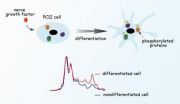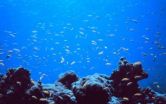(Press-News.org) On 5 and 6 June this year, millions of people around the world will be able to see Venus pass across the face of the Sun in what will be a once-in-a-lifetime experience.
It will take Venus about six hours to complete its transit, appearing as a small black dot on the Sun's surface, in an event that will not happen again until 2117.
In this month's Physics World, Jay M Pasachoff, an astronomer at Williams College, Massachusetts, explores the science behind Venus's transit and gives an account of its fascinating history.
Transits of Venus occur only on the very rare occasions when Venus and the Earth are in a line with the Sun. At other times Venus passes below or above the Sun because the two orbits are at a slight angle to each other. Transits occur in pairs separated by eight years, with the gap between pairs of transits alternating between 105.5 and 121.5 years – the last transit was in 2004.
Building on the original theories of Nicolaus Copernicus from 1543, scientists were able to predict and record the transits of both Mercury and Venus in the centuries that followed.
Johannes Kepler successfully predicted that both planets would transit the Sun in 1631, part of which was verified with Mercury's transit of that year. But the first transit of Venus to actually be viewed was in 1639 – an event that had been predicted by the English astronomer Jeremiah Horrocks. He observed the transit in the village of Much Hoole in Lancashire – the only other person to see it being his correspondent, William Crabtree, in Manchester.
Later, in 1716, Edmond Halley proposed using a transit of Venus to predict the precise distance between the Earth and the Sun, known as the astronomical unit. As a result, hundreds of expeditions were sent all over the world to observe the 1761 and 1769 transits. A young James Cook took the Endeavour to the island of Tahiti, where he successfully observed the transit at a site that is still called Point Venus.
Pasachoff expects the transit to confirm his team's theory about the phenomenon called "the black-drop effect" – a strange, dark band linking Venus's silhouette with the sky outside the Sun that appears for about a minute starting just as Venus first enters the solar disk.
Pasachoff and his colleagues will concentrate on observing Venus's atmosphere as it appears when Venus is only half onto the solar disk. He also believes that observations of the transit will help astronomers who are looking for extrasolar planets orbiting stars other than the Sun.
"Doing so verifies that the techniques for studying events on and around other stars hold true in our own backyard. In other words, by looking up close at transits in our solar system, we may be able to see subtle effects that can help exoplanet hunters explain what they are seeing when they view distant suns," Pasachoff writes.
Not content with viewing this year's transit from Earth, scientists in France will be using the Hubble Space Telescope to observe the effect of Venus's transit very slightly darkening the Moon. Pasachoff and colleagues even hope to use Hubble to watch Venus passing in front of the Sun as seen from Jupiter – an event that will take place on 20 September this year – and will be using NASA's Cassini spacecraft, which is orbiting Saturn, to see a transit of Venus from Saturn on 21 December.
"We are fortunate in that we are truly living in a golden period of planetary transits and it is one of which I hope astronomers can take full advantage," he writes.
From 12.00pm (Midday) BST, the article will appear online at http://physicsworld.com/cws/article/indepth/2012/may/01/venus-its-now-or-never
Also in this issue:
Fukushima fallout – Steven Judge from the UK's National Physical Laboratory reports from Japan, where he and co-author Hiroyuki Kuwahara have been monitoring radioactive contamination around the stricken Fukushima Daiichi reactor
Defeating diffraction – once thought to offer imaging at unlimited resolution beyond that permitted by diffraction, "superlenses" never quite worked in practice, but physicists now have a host of other ideas that could make perfect images, as Jon Cartwright reports
###
Please mention Physics World as the source of these items and, if publishing online, please include a hyperlink to: http://physicsworld.com
Notes for editors:
1. Physics World is the international monthly magazine published by the Institute of Physics. For further information or details of its editorial programme, please contact the editor, Dr Matin Durrani, on tel +44 (0)117 930 1002. The magazine's website physicsworld.com is updated regularly and contains physics news, views and resources. Visit http://physicsworld.com.
2. For copies of Physics World and copies of the articles reviewed here contact Michael Bishop, IOP Press Officer, tel +44 (0)117 930 1032, e-mail michael.bishop@iop.org.
3. The Institute of Physics is a leading scientific society promoting physics and bringing physicists together for the benefit of all.
It has a worldwide membership of around 40,000 comprising physicists from all sectors, as well as those with an interest in physics. It works to advance physics research, application and education; and engages with policymakers and the public to develop awareness and understanding of physics. Its publishing company, IOP Publishing, is a world leader in professional scientific communications. Go to http://www.iop.org
END
WASHINGTON, April 30--Atomic clocks based on the oscillations of a cesium atom keep amazingly steady time and also define the precise length of a second. But cesium clocks are no longer the most accurate. That title has been transferred to an optical clock housed at the U.S. National Institute of Standards and Technology (NIST) in Boulder, Colo. that can keep time to within 1 second in 3.7 billion years. Before this newfound precision can redefine the second, or lead to new applications like ultra-precise navigation, the system used to communicate time around the globe ...
Knowing how a living cell works means knowing how the chemistry inside the cell changes as the functions of the cell change. Protein phosphorylation, for example, controls everything from cell proliferation to differentiation to metabolism to signaling, and even programmed cell death (apoptosis), in cells from bacteria to humans. It's a chemical process that has long been intensively studied, not least in hopes of treating or eliminating a wide range of diseases. But until now the close-up view – watching phosphorylation at work on the molecular level as individual cells ...
ROCHESTER, Minn. -- Researchers studying multiple sclerosis(MS) have long been looking for the specific molecules in the body that cause lesions in myelin, the fatty, insulating cells that sheathe the nerves. Nearly a decade ago, a group at Mayo Clinic found a new enzyme, called Kallikrein 6, that is present in abundance in MS lesions and blood samples and is associated with inflammation and demyelination in other neurodegenerative diseases. In a study published this month in Brain Pathology, the same group found that an antibody that neutralizes Kallikrein 6 is capable ...
Scientists predict ocean temperatures will rise in the equatorial Pacific by the end of the century, wreaking havoc on coral reef ecosystems.
But a new study shows that climate change could cause ocean currents to operate in a way that mitigates warming near a handful of islands right on the equator.
Those islands include some of the 33 coral atolls that form the nation of Kiribati. This low-lying country is at risk from sea-level rise caused by global warming.
Surprisingly, these Pacific islands within two degrees north and south of the equator may become isolated ...
Brand India is the name of the organisation that since the late 1990's has been tasked with convincing international corporations and heads of state that they should invest in new, modern India. In return for their investment, they get, among other things, access to cheap, well-educated labour.
"The branding campaigns produce seductive images of 'new' India: In the beginning the ads placed traditional Indian motifs together with images of mobile phones, computers, and motor ways to show the investors how India has developed," says Ravinder Kaur, who is director of Centre ...
The common antibiotic, amoxicillin-clavulanate, may improve small bowel function in children experiencing motility disturbances, according to a study appearing in the June print edition of the Journal of Pediatric Gastroenterology and Nutrition from Nationwide Children's Hospital.
Amoxicillan-clavulanate, also known as Augmentin, is most commonly prescribed to treat or prevent infections caused by bacteria. However, it has also been reported to increase small bowel motility in healthy individuals and has been used to treat bacterial overgrowth in patients with chronic ...
COLUMBUS, Ohio – Just 20 minutes of playing a violent shooting video game made players more accurate when firing a realistic gun at a mannequin – and more likely to aim for and hit the head, a new study found.
Players who used a pistol-shaped controller in a shooting video game with human targets had 99 percent more completed head shots to the mannequin than did participants who played other video games, as well as 33 percent more shots that hit other parts of the body.
In addition, the study found that participants who reported habitual playing of violent shooting ...
COLUMBUS, Ohio - People aren't very good at media multitasking - like reading a book while watching TV - but do it anyway because it makes them feel good, a new study suggests.
The findings provide clues as to why multitasking is so popular, even though many studies show it is not productive.
Researchers had college students record all of their media use and other activities for 28 days, including why they used various media sources and what they got out of it.
The findings showed that multitasking often gave the students an emotional boost, even when it hurt their ...
Boulder, Colo., USA – Studies in this Geology posting cover direct dating of brittle fault activity along the Dead Sea fault zone in Northern Israel; onset of the last deglaciation of valley glaciers in southern Patagonia; cutting-edge techniques, including NanoSIMS ion mapping, to identify the microbial metabolism involved in ooid cortex formation; slope failure at Scripps Canyon, California; and the continuing and relatively quick uplift of the U.S. Sierra Nevada, which gains 1-2 mm per year in elevation.
Highlights are provided below. Geology articles published ahead ...
University of Iowa biologists have advanced the knowledge of human neurodevelopmental disorders by finding that a lack of a particular group of cell adhesion molecules in the cerebral cortex -- the outermost layer of the brain where language, thought and other higher functions take place -- disrupts the formation of neural circuitry.
Andrew Garrett, former neuroscience graduate student and current postdoctoral fellow at the Jackson Laboratory, Bar Harbor, Maine; Dietmar Schreiner, former postdoctoral fellow currently at the University of Basel, Switzerland; Mark Lobas, ...


